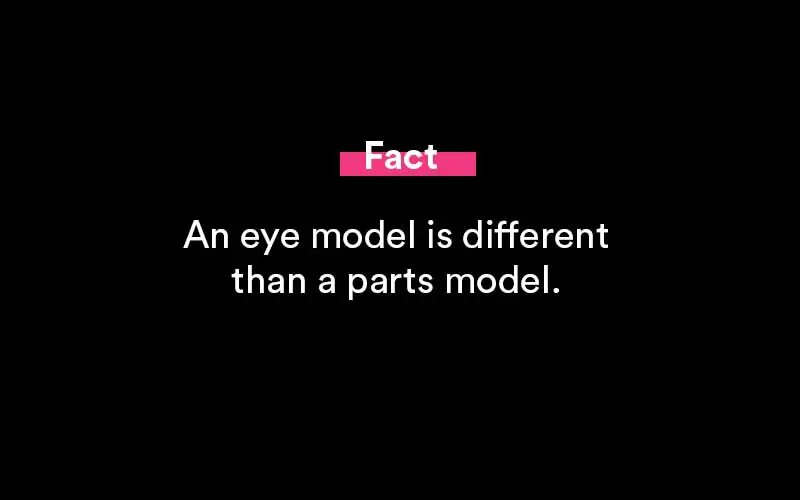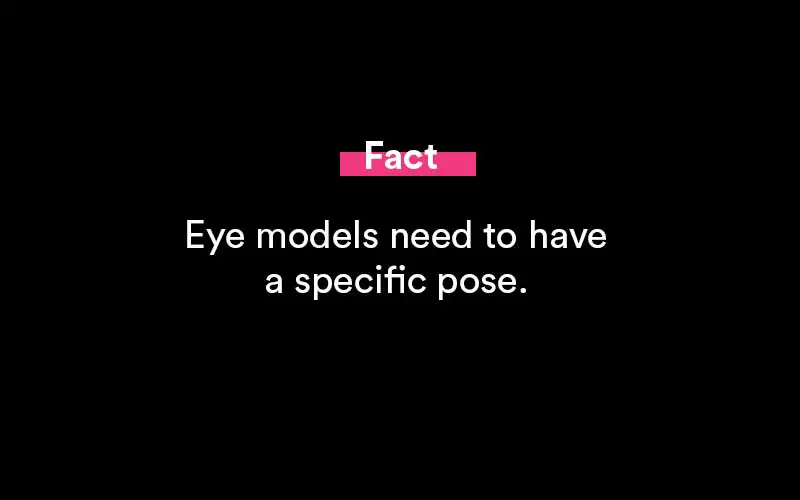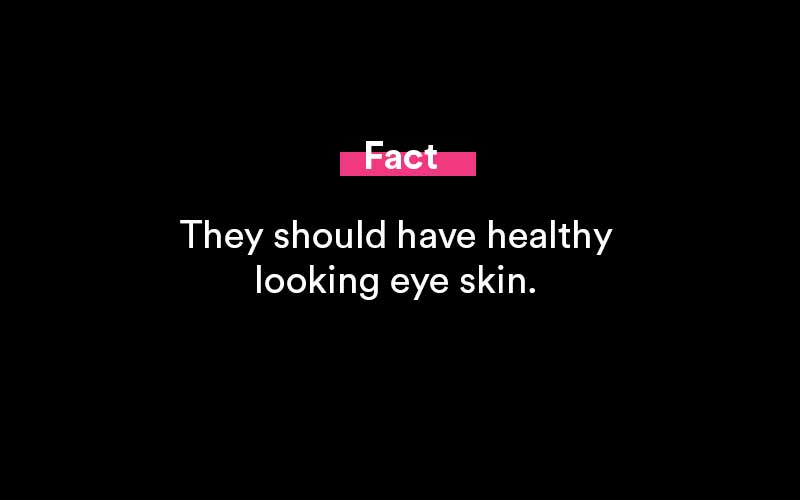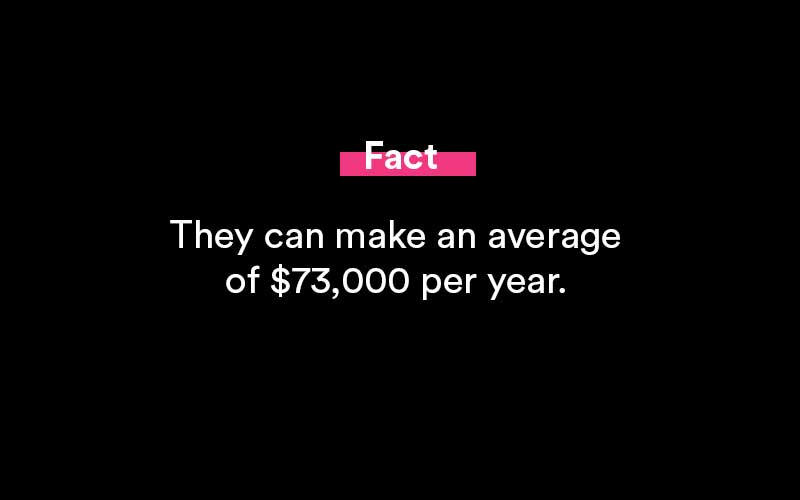What is Eye Modeling? How to Become an Eye Model
What is eye modeling? Within the wider spectrum of the modeling industry, eye modeling is a specialized market. You could love a job as an eye model if you enjoy posing for the camera, promoting items, or consider your eyes to be one of your favorite face characteristics.
Here's how to become an eye model.

What is an eye model?
An eye model is someone who agrees to have their eyes and other body parts photographed for commercial or educational purposes. They are frequently commercial models, which means they operate on a contract basis and are booked for a range of customers or purposes. Part modeling, which includes eye models, is a significant section of the modeling industry.
What is parts modeling?
Parts modeling is a subset of the wider modeling business in which specialists focus on a single body component. Other forms of parts modeling, other than eyes, include:
- Feet
- Hair
- Hands
- Legs
- Lips
- Teeth
Modeling for feet, hair, hands, legs, lips, and teeth is a niche market for models with one especially beautiful or unique feature. When first starting out in the modeling profession, it can be helpful to work as a parts model to gain experience and keep control over a single body part.
What does an eye model do?
An eye model follows a precise set of instructions for each assignment in order to get the intended appearance, attitude, or mood for the campaign. An eye model's responsibilities can include the following:
- Working with directors and designers to express a piece's message.
- determining and negotiating important booking parameters including contract duration, salary, workdays and times, transport, and any other details.
- To keep a decent look, follow personal health recommendations as needed.
- Following a photographer's, director's, or other creatives' instructions.
- To schedule and confirm the details of each engagement, I interact with agencies, designers, photographers, and clients.
- Arriving on time and engaging professionally with staff and crew members to maintain a commitment to excellence for each assignment.
- To identify and book gigs, I meet with potential clients and agencies.
- In front of the camera, posing for artists and photographers.
- Traveling to photoshoots and other similar duties as needed.
Skills of an eye model
In the course of their everyday tasks, eye models can employ interpersonal, physical, and individual abilities. The following are some of the qualities that an eye model should have in order to be successful in their field:
- Ability to sit, stand, or do other activities for long periods of time.
- Flexibility .
- Discipline .
- Attention to detail.
- Hygiene.
- Obedience.
- Organization/Persistence.
- Written and spoken communication are both important.
Industries for an eye model
Eye models can collaborate with advertising agencies and clients on a wide range of items. Some of the items for which eye models appear in advertisements include:
- Acne medication
- Allergy medication
- Beauty face masks
- Contact lenses
- Eyebrow grooming services
- Eyedrops
- Eyeglasses
- Eyeliner
- Eyeshadow
- Facial scrubs
- False eyelashes
- Makeup brushes
- Mascara
Types of jobs for an eye model
Eye models can arrange a variety of campaigns in a variety of channels to promote items in still and moving images.
The following are examples of advertising materials for which eye models can pose:
- Artwork for the album.
- Brochures.
- Advertisements in magazines.
- Paintings.
- Packaging for a product.
- Posters for advertising.
- Sculptures\Sketches.
- Images from the public domain.
- Advertisements on television.
How to become an eye model
To learn how to become an eye model, follow these steps:
Meet the requirements
To get their first work, most eye models don't require a certain degree of schooling or a set number of years in the field. Eye models, unlike other sorts of models, are not need to satisfy height and weight requirements in order to be considered for specific roles. Skin and eyes that are free of blemishes are among their minimal criteria. Some agencies can have an age restriction for representation, such as 16 or 18. On a case-by-case basis, certain customers or agents can specify extra criteria.
Protect your eyes
Models with clean eyes and no apparent veins can be sought after by agents and clients. They could also be on the lookout for models with eyes that are almost equal in shape and size on both sides of their faces. Genetics can have a role in some of these aspects. There are, however, steps you can do to keep your eyes as healthy as possible. They are as follows:
- Seeing an optometrist on a frequent basis to examine your eye health and address any concerns.
- To stay hydrated and avoid the appearance of bloodshot eyes, avoid coffee.
- consuming nutrient-dense, fresh meals such as veggies
- To minimize bags and puffiness, get adequate sleep each night.
- To avoid eye strain, limit your screen time.
- To avoid dry, dull, or swollen eyes, drink plenty of water.
- To avoid discomfort, wear glasses instead of contact lenses.
- To avoid dryness and discomfort, use UV-protected sunglasses throughout the year.
Take care of your skin
The skin around your eyes, such as your cheeks, forehead, and eyelids, will be seen in most eye modeling projects. Take steps to keep your skin looking young and company. Prevent dark circles, bags, wounds, scars, bruises, and acne by following beauty and lifestyle routines. You can also want to avoid getting face tattoos or dermal piercings since they can hinder you from getting certain professions. To avoid irritation, avoid using skincare or cosmetics items to which you are allergic, and test new products on another region of your skin, such as an arm or leg, before using them on your face.
Get your eyebrows done
The brows of an eye model, like the skin around them, can appear on camera. To eliminate any undesirable hairs and maintain a consistent and attractive shape, schedule frequent brow grooming sessions such as plucking, waxing, threading, or microblading.
Practice your expressions
The ability to maintain total control over your eye and face muscles at all times is a crucial talent for an eye model. This allows you to provide the creatives and the camera with certain expressions or looks on demand at each booking. Learn how to convey a wide range of emotions, such as pleasure, sadness, fear, and other expressions, using just your eyes and upper facial muscles, so that they look genuine when filmed for marketing materials. Consider rehearsing your facial expressions in front of the mirror or studying photographs of yourself.
Study required material
Consider looking at eye model advertisements on the internet and in magazines, as well as brochures, billboards, and other marketing materials. Reviewing relevant resources can also help you practice your phrases and have a better understanding of the industry's content demands.
Take professional portfolio pictures
When you're attempting to persuade an agency to respond to booking calls from talent scouts, they can request photographs with your application or portfolio. You can pay for professional head and eye pictures, but you can also snap images at home and submit them with your documents. Consider utilizing a digital camera rather than a camera phone to capture high-quality photos. To present your most realistic look, avoid editing your photos. Pose with various emotions and shoot a range of photos, including close-ups, headshots, and images with and without makeup, if applicable.
Get a representative
Working with a modeling agency or agent can help you locate more open gigs and book them more swiftly. Look for agencies that embrace new talent and are recognized by the Better Business Bureau. If you're new to the sector, certain companies can specialize in components modeling, which might be beneficial.
Take opportunities
When you're given work, accept as many as you can fit into your schedule or as many as you feel comfortable completing at once. This might help you expand your portfolio and network with more industry professionals. Your network will grow as you meet more people, which will help you learn about more chances. To develop your network, go to trade exhibitions, beauty expos, and other such events. To broaden your reach and adaptability, you could choose modeling jobs other than eye modeling, such as fashion or other types of parts modeling.
Create a portfolio
Add the test photographs, examples of your final products, and ads to your professional portfolio as you complete additional tasks.
This body of work might be stored digitally, such as on a website or a professional social networking site. You can also create a hard-copy portfolio to bring to agency or scouting meetings.

Other items to consider adding to your portfolio are:
- A list of the companies you've worked for.
- Agents and clients with whom you've worked, including their names and contact information.
- Educated or other past work experience should be included on your resume.
- Modeling styles you've used, such as digital, print, and other mediums.
Work environment for an eye model
Many eye models work on a contract basis. Rather than being paid on a salary, they are usually compensated by the task or by the hour. Some people, on the other hand, can work as full-time eye models and obtain perks like as paid time off and insurance choices similar to those offered to typical office workers. Eye models can wear a range of accessories or products, such as cosmetics, spectacles, contact lenses, or other promotional things, while on the job.
Eye models can go to a photoshoot location, work indoors or outdoors, and in a variety of temperatures and weather conditions, depending on the campaign. They can collaborate with other models, agents, directors, photographers, and crew members in big groups.

Salary for an eye model
This industry pays an average of $73,347 per year. Your real pay can vary based on the sort of modeling you perform, where you work, and who you work for.
Models can be eligible for the following benefits:
- Assistance for commuters
- Dental coverage is a must.
- Discounts for employees
- Adaptable schedule
- Food will be supplied.
- Health-care coverage
- Parental leave is a period of time when a parent
- Assistance with professional growth
- Payment for tuition
- Insurance for your eyes
- Options for working from home
- 401(k)
Job outlook
The Bureau of Labor Statistics, like the pay statistics, does not provide particular career outlook information for an eye model. However, they predict the modeling sector will expand at a rate of 1% over the next ten years, which is slower than the average for other fields in the US.
Common questions
Questions from job seekers.
What does it take to become an eye model?
Amazing or unique eyes is only the start. You'll need different expressions for various settings. Practice constantly staring into a basic digital camera to hone your skills. Make sure to protect your entire face from harm at all times. The skin surrounding your eye should be tight and youthful. Successful eye models have a unique face, while having expressive eyes.

Popular Resources

Featured
35+ Phone Interview Questions & Best Sample Answers
Phone interviews have become a core part of the process when attempting to find a secured placement for an open position. Companies receive massive responses from potential candidates for any..

Featured
12+ Best Questions To Ask A Recruiter
Concerning a job search, you might receive numerous offers from your recruiters. Before you choose one, you need to assess all the conditions, for which it is vital that you know everything associated with the offered position..

Featured
Answering "What Makes You Unique" In A Job Interview
Answering this question during a job interview requires more than knowing why you are unique as an individual. Yes, the true scientific answer is made up of two main components: your..

Featured
250+ Ice Breaker Questions for Life
An ice breaker question is a question that’s asked from one person to another person in order to act as a conversation starter. It brings a connection...

Featured
10 Best Answers to "What Motivates You?"
Open-ended questions like “What motivates you?” can elicit a deer-in-the-headlights reaction from job candidates if they are unprepared. It’s a broad question and can leave the interviewer..

Featured
Answering "How Did You Hear About This Position" In An Interview
A lot of interviewers ask this question - how did you hear about this position? This way they can judge you if you are a passive or an active job seeker..

Featured
8 Best Thank You Emails After an Interview (Samples, Free Templates)
Writing a thank you note after an interview says a lot about you as a potential employee. Most notably, it says that you care about the opportunities presented..

Featured
Writing a Resignation Letter (How To Write It, Samples)
Writing the perfect letter of resignation is more of an art than it is a science. And we’re going to cover how to master that art form in this full guide..

Featured
How to End a Letter (Example Salutations, Sign Off's)
Knowing how to end a business note or email is an important skill to develop. It helps portray a sense of confidence, respect and tone to your message..
